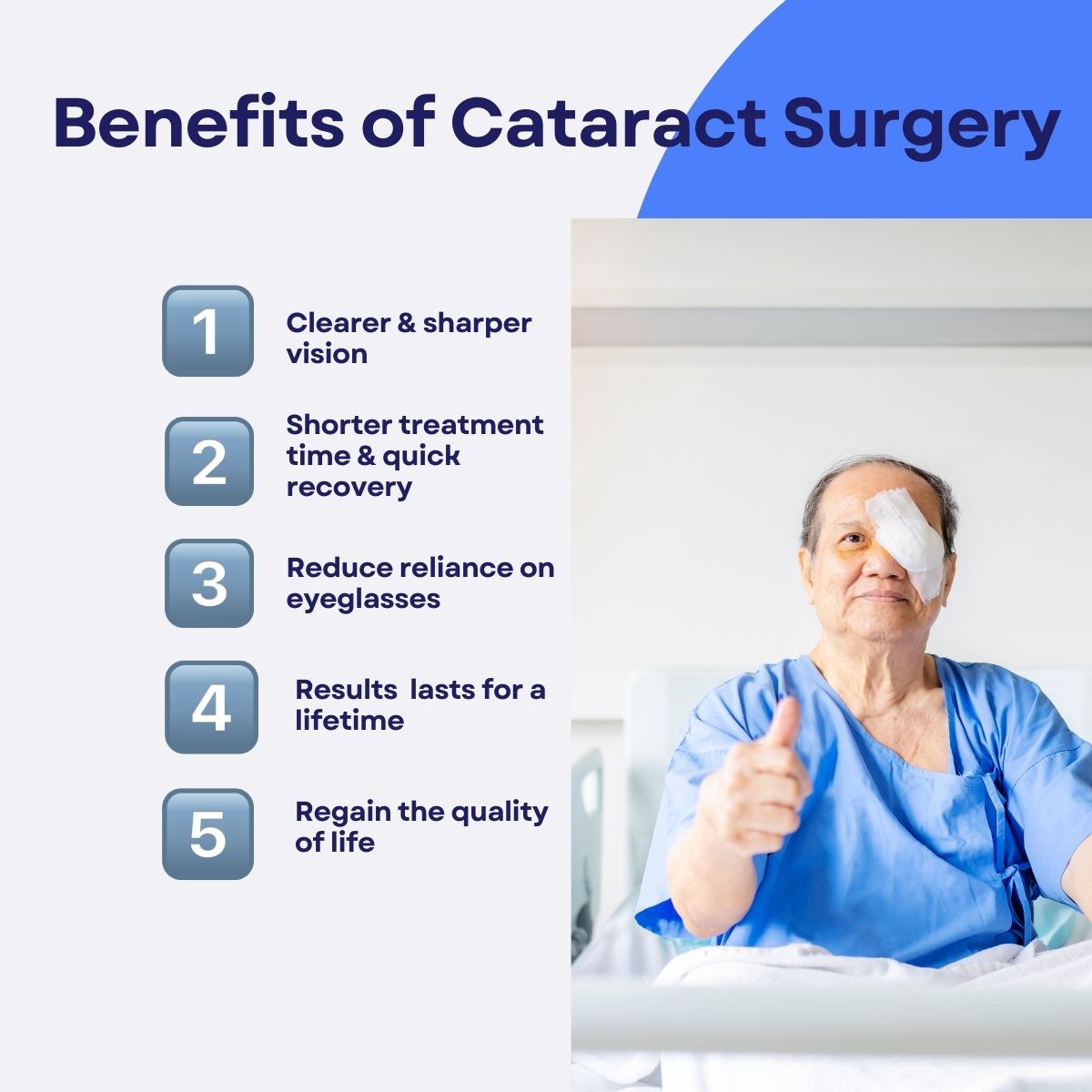What Are the Disadvantages of Cataract Surgery? Things Doctors May Not Mention

Prathyusha Itikarlapalli
- Content Writer

Dr. Natalia Hernandez Martinez
- Reviewed by

Table of contents
- Understanding Cataracts and Their Treatment
- How Safe Is Cataract Surgery?
- Key Benefits of Cataract Surgery
- Potential Drawbacks and Risks
- Common Post-Surgery Problems
- Serious Complications That May Lead to Vision Loss
- Types of Cataract Surgery Explained
- Lens-Related Concerns After Surgery
- Managing and Preventing Long-Term Side Effects
Key Takeaways
- Cataract surgery can cause temporary blurry vision, dry eyes, itching, a sensation of sand or dust particles in the eye, redness, and discomfort. These are a part of the normal healing process, so using lubricating eyedrops and protecting the eyes from chemicals, irritants, and pollutants helps in a smoother recovery.
- Although rare, cataract surgery can lead to permanent vision loss due to infection, retinal detachment, IOL dislocation, pressure changes, and posterior capsular opacification. Choosing the right ophthalmologist, clear candidate evaluation, and adherence to aftercare measures can help avoid these serious, less common complications.
- Cataract surgery relies on high-end technology, and the costs are quite high. Insurance covers traditional methods and standard IOLs. Advanced laser methods and specialized IOLs are considered elective and can be costly when planned privately.
Basic Understanding of Cataracts and Their Surgical Removal
While cataracts are a leading cause of vision problems worldwide, surgical removal remains the most effective and successful treatment method.[1] The clear eyelens becoming thicker and denser day by day, hazing the eyesight, makes it difficult to see objects and even perform daily tasks. While cataracts are more prevalent in elderly individuals, younger individuals are also at risk. The unusual protein buildup within the natural eyelens creates a cloudy or blurry eyesight, with faded colors and difficulty seeing lights due to halos and glare. Thanks to the surgical advancements! Ophthalmologists perform cataract eye surgery to remove the clouded eye lens and replace a clear intraocular lens.
Note that ophthalmologists do not perform surgery as soon as cataracts are formed. Lens clouding is a gradual process, and surgical removal is carried out only when the cataracts are thick enough to interfere with routine daily tasks. So if you are wondering when to have cataract eye surgery, worry not, as your ophthalmologist will check this for you.
Cataract Surgery: How Safe Is It?
Cataract surgery is generally safe with the least chances for complications. While a few temporary side effects, such as blurriness, glare, halos, and dryness, are quite common, these usually resolve in a few days. Rarely are the post-surgical complications serious enough to cause permanent vision loss.
What Are the Positives of Cataract Surgery?
By undergoing cataract surgery, you will enjoy clearer and sharper vision. Your reliance on eyeglasses decreases off and you will see colors more vividly. Plus, you don’t have to worry about the glare and halos that disturb vision during night or in dim light. More importantly, the surgery is simple, with shorter treatment and recovery time. Being minimally invasive, you don’t require an overnight hospital stay and can return home the same day after the procedure. While you regain the quality of life, the benefits are long-lived. The permanent removal of dense cataract eyelens offers clarity that lasts for a lifetime.

Like any other medical procedure, cataract surgery also has its negatives. It's crucial to understand the pros and cons of the procedure before making a decision.
What Are the Negatives of Cataract Surgery?
While cataract surgery is generally safe and successful, you’re required to follow the aftercare measures with utmost care and attention. With surgery, you will regain clear vision; however, the way you train your eyes after cataract surgery affects the quality of the outcomes. Besides, the surgery carries minimal risks and post-surgical complications to some extent. Furthermore, the expenses for the surgery are significantly higher when it is done privately. While insurance covers cataract surgery, it is limited only to the traditional method. And when you choose it on a private basis, the surgical costs can be a burden. The types of cataract surgery and cost vary depending on the lens chosen, the technique used, and even the geographical location. These cost factors, along with the complications, can make cataract surgery a difficult choice for some patients.
Now, let’s head over to understand the simple and complicated issues associated with cataract surgery.
What Are the Most Common Problems After Cataract Surgery?
Blurriness, dry eyes, itching, grittiness, and light sensitivity are the most common issues experienced after cataract surgery. These are accompanied by redness and inflammation, with mild pain and discomfort. Note that these temporary problems are a normal part of the healing process in most cases. The sensitive eye tissues swell and accumulate fluids as they heal the surgical incisions. This causes hazy vision, with itching and grittiness. Damage to the corneal nerves, which signal the formation of tears, causes dry eyes. These issues are not long-lived in most cases. They typically subside with effective care during the early stages of healing. All you need to do is follow the aftercare instructions effectively.

What Causes Blindness After Cataract Surgery?: A Brief on the Complications That Are Serious!
Cataract surgery rarely leads to severe complications, but when they do occur, they can threaten vision. Serious risks include infection, bleeding, posterior capsular opacification, increased eye pressure, intraocular lens (IOL) dislocation, and retinal detachment. Mild symptoms such as dryness, itching, or a gritty sensation are common and usually temporary. However, severe pain, sudden vision loss, or redness with discharge should never be ignored. Seek immediate medical attention from your ophthalmologist for early detection and prompt treatment.
- Infection: Infection resulting from bacterial or fungal entry during or after a surgical procedure can cause severe damage to the sensitive tissues of the eye. When left untreated, it can lead to permanent loss of eyesight.
- Bleeding: Excessive bleeding resulting from damage to blood vessels or pressure changes within the eye can lead to serious complications, including vision loss.
- Posterior capsular opacification: It can happen when the lens epithelial cells leak into the membrane holding the IOL, causing secondary cataract. PCO causes a significant amount of vision impairment, associated with haziness and blurry vision.
- Increased eye pressure: In some candidates who underwent cataract surgery, either the surgical trauma or the leftover lens debris can block the eye's drainage system. This results in pressure building up, causing blurry images and can also block the blood vessels that carry blood to the retina.
- IOL dislocation: The eye structures, such as the capsular bag or zonular fibres, hold the IOL in place. IOL dislocation happens when these are damaged during the surgical procedure or are weakened gradually after the procedure. This causes blurry images, dark curtains, and bright flashes, necessitating a second surgery to reposition the IOL.
- Retinal detachment: Cataract surgery can cause significant changes in the vitreous humour, the gel that fills the eye. This causes the retina to be pulled back, potentially leading to a tear or detachment. The consequences are quite serious and may even lead to loss of vision.
Factors That Increase the Risk of Cataract Surgery Complications
Although the complications associated with cataract surgery are diverse, certain factors increase the risk of developing visual problems after cataract surgery.
- Age: Elderly individuals aged above 70-80 years are more likely to experience complications and poor visual outcomes after cataract surgery. The weaker tissues and the likelihood of systemic health issues increase the risk for posterior capsular tears, vitreous loss, and corneal edema.[2]
- Systemic conditions: Suffering from chronic health issues such as diabetes, hypertension, and autoimmune diseases such as lupus can increase the risk of developing complications. These either impact healing or eye health, stressing the importance of clear candidate selection before surgery.[3]
- Medications: Blood thinners, such as aspirin and warfarin, increase the risk of bleeding during cataract surgery. On the other hand, alpha-blockers such as Tamsulosin, used to treat prostate issues, deeply soften the iris, making it floppy during the surgery. This can also damage the iris and posterior capsule.[4]
- Pre-existing eye conditions: Candidate screening is a crucial process for ensuring the success of cataract surgery. Eye issues such as glaucoma, macular degeneration, small pupils, or a previous history of vitrectomy increase the likelihood of post-surgical complications.
- Surgical practice: Cataract surgery requires precision, and an improperly carried out procedure can influence its success. Capsular tear, loss of vitreous, leakage of lens endothelial cells, and the risk of infections are a few, but serious, outcomes of inappropriately handled surgical techniques. A careful evaluation of candidacy and adherence to modern techniques reduces the risk of complications arising from surgical errors.
When we discuss cataract surgical technique, it may seem straightforward, as it involves removing the cataract lens and replacing it with a clear IOL. However, speaking in terms of technicality, the procedures vary considerably. We discussed the common cataract surgery procedures and briefed on the major disadvantages associated with them.
What Are the 3 Types of Cataract Surgery?
Phacoemulsification, extra-capsular cataract extraction, and intra-capsular cataract extraction are the three types of cataract surgery procedures.
Phacoemulsification relies on breaking down the cloudy lens using ultrasound waves and removing it using suction force. Since it involves smaller incisions, the treatment time and recovery are quick. It is generally performed as the manual method, where ophthalmologists make a surgical incision on the sensitive eye parts to reach the dense cataract. The other approved and largely followed method is the laser-assisted cataract surgery. Ophthalmologists employ femtosecond lasers to create incisions and soften the cataracts, while its broken into pieces using ultrasound energy.
Extra-capsular cataract extraction (ECCE) involves removing the cataract as a single piece by making a larger incision and leaving the capsule intact. ECCE is considered a conventional method and is preferred for cataracts that are too dense to break into pieces. The recovery period is relatively longer compared to the minimally invasive phacoemulsification.
The other, less preferred intra-capsular cataract extraction (ICCE) method removes the dense cataract along with the capsule holding it. Hence, it requires a larger incision and is less preferred because it entails a longer healing time and can also lead to certain complications. The ICCE is performed in rare cases where the capsule is damaged and needs to be removed.
Having known the approved cataract surgery types, it's time for a quick read on the most commonly asked questions regarding cataract eye surgery.
What Are the Disadvantages of Manual Cataract Surgery?
The manual cataract surgery requires a relatively longer time to heal, with some amount of post-procedural discomfort. Unlike the laser methods that rely on advanced tools, manual cataract surgery lacks visual guidance. Since the ophthalmologists make surgical incisions, the method can result in minor precision errors. Therefore, candidates are more likely to experience minor complications, such as eye inflammation, and require long-term post-procedural care.[5] Plus, adherence to the post-procedural care decides the success of the procedure.
What Are the Disadvantages of Laser Cataract Surgery?
Laser cataract surgery utilizes high-end technology to offer precision, but its major disadvantage is the higher costs. The reliance on advanced lasers and computer-guided systems makes the procedure an expensive one. More importantly, ophthalmologists charge high prices for the laser methods because the equipment requires ongoing maintenance, which adds to the overhead costs. Furthermore, doctors require frequent training and procedure upgrades as technology advances.[6]
In addition to the cost factors, the method can rarely cause intraoperative risks of iris damage and incomplete incisions, requiring surgeons to complete it manually. The action of lasers on the pupillary edges can release prostaglandins. This can cause the pupil to constrict, making the subsequent steps of the procedure more difficult.[7] Additionally, the laser methods aren’t covered by Medicare or many other private health insurance plans, as they are considered elective procedures.
Lens-Related Issues
Ophthalmologists replace the dense cataract lens with an artificial IOL, and the outcomes vary based on the IOL type. Cataract surgery lens options are made based on the candidate's vision requirements and eye conditions. Patients may be offered lens choices such as multifocal, monofocal, toric, EDOL, and accommodating IOLs. While some are intended to accommodate conditions such as astigmatism, others are designed to reduce dependence on glasses. Each one carries its pros and cons.
What Are the Disadvantages of Monovision Cataract Surgery?
Candidates undergoing monovision cataract surgery may experience temporary vision difficulties during the early stages of their recovery. Undergoing a monovision cataract surgery means getting two different IOLs into each eye. One IOL helps distant vision, while the other one facilitates near vision. So, the brain needs to adapt accordingly to create a blended image, which can take time. And because the brain processes near and far-off objects, most individuals often experience discomfort with depth perception and precise distance judgment. They often face difficulty seeing in dim light and would require assistance for night driving due to glare and halos.
What Are the Disadvantages of Toric Lens for Cataract Surgery?
While toric IOLs offer clear vision for astigmatism, these customized choices are often associated with higher costs. Further, they may cause undercorrection or overcorrection of the refractive issue due to lens rotation. Astigmatism, typically, is a condition of an irregular or football-shaped cornea, leading to the formation of blurry images. The toric IOL features different powers at various parts of the lens to correct uneven corneal curvature and form clear images. However, the surgical procedure allows IOL placement within the capsular bag, which may contract, causing the IOL to rotate after a brief period following the surgery. In such cases, a second surgery is necessary to reposition the toric IOL and achieve clear vision. [8]
What Are the Disadvantages of Dropless Cataract Surgery?
Increased intraocular pressure and temporary blurriness (lasting a few days) are the common, less severe disadvantages of dropless cataract surgery. While using artificial tears (eye drops) after cataract surgery is the most common aftercare step, the dropless cataract surgery is intended to reduce its need. The medicine to cope with the post-procedural discomfort is either injected during the procedure or is set in the form of drug-eluting implants (IOLs). This can increase the eye pressure in some candidates. Furthermore, not everyone is a suitable candidate, as the procedure is not recommended for conditions such as glaucoma. [9]
What Are the Disadvantages of Trifocal Lenses After Cataract Surgery?
Trifocal lenses implanted after cataract removal are designed to provide clear vision at near, intermediate, and far distances. These lenses have multiple focal points and are often associated with higher costs. While these can improve your eyesight, allowing you to drive, read, and work on a screen with ease, your brain will require longer adaptation periods. Furthermore, less severe post-surgical complications, such as halos, glare, and starbursts, are quite common.
Can You Avoid the Long-Term Side Effects of Cataract Surgery?
Yes, you can avoid long-term side effects of cataract surgery by adopting the following measures:
- Opt for a skilled and experienced ophthalmologist with a proven record of success.
- Discuss your pre-existing medical and eye conditions, any ongoing medications, or previous history of eye surgeries.
- Follow the post-surgical aftercare measures mentioned by your ophthalmologist without fail.
- Use the prescribed eye drops, avoid irritants or chemicals that come into contact with your eyes, and refrain from rubbing them.
- Protect your eyes from bright lights and pollutants.
- Restrain from performing strenuous physical activities during the early days after cataract surgery.
- Attend follow-up appointments to monitor progress and identify potential issues early on.
Final Word!
While cataract surgery is generally safe and effective, it’s essential to weigh the potential risks against the benefits. The right guidance can make all the difference in preparing for surgery and ensuring peace of mind throughout the process!
At Envoy Health, we connect you with trusted specialists and provide the support you need at every step of your journey. Sign up with Envoy Health today and take the first step toward safer, more confident care.
References
- Changing Patterns In Cataract Surgery Indications, Outcomes, And Costs, 2012–2023: A Retrospective Study At Aravind Eye Hospitals, India
- A Primary Care Provider’s Guide To Cataract Surgery In The Very Elderly
- Predisposing Factors For Severe Complications After Cataract Surgery: A Nationwide Population-Based Study
- The Ocular Adverse Effects Of Oral Drugs
- A Review Of Laser-Assisted Versus Traditional Phacoemulsification Cataract Surgery
- Are Fees For Cataract Surgery Still Too High?
- The Benefits And Drawbacks Of Femtosecond Laser-Assisted Cataract Surgery
- Femtosecond Laser-Assisted Cataract Surgery
- Toric Intraocular Lenses
- Steroid Response Following Dropless Cataract Surgery Using Subconjunctival Triamcinolone
Disclaimer
The information in this article is for educational purposes only and does not replace medical advice. Always consult your doctor before starting any treatments.
Candidates with eye problems such as macular degeneration, detached retina, and glaucoma should avoid cataract surgery. Besides, those on medications such as blood thinners and alpha blockers may also face risks after cataract surgery. It's essential to discuss these issues with your ophthalmologist before undergoing the procedure.
The biggest complaint after cataract surgery is that candidates experience discomfort due to blurriness, dry eyes, light sensitivity, glare, halos, starbursts, and difficulty with night vision. These issues are temporary and can be easily addressed with appropriate aftercare measures. Covering the eyes with a protective eyeshield, using the prescribed lubricant eye drops, and avoiding contact with irritants and chemicals while you heal can help alleviate these complaints.
Many suggest that vitamins A, C, and E, along with lutein and zeaxanthin, are effective in preventing cataracts from worsening. Cataracts are known to occur as a result of oxidative stress-induced denaturation of lens proteins. Relying on a healthy diet and incorporating vitamins and antioxidants can help slow down protein degradation and the process of clouding.
Some candidates feel dissatisfied with cataract surgery outcomes due to monovision, residual refractive errors, and inappropriate depth perception. These issues may seem similar to blurriness, but the underlying cause of the issue isn’t just healing (as it often occurs with common hazy vision after surgery). Addressing them may require a repeated surgical procedure, contact lenses, or thick-framed glasses.
Cataract surgery risks include infection, inflammation, retinal detachment, swelling, and edema. These are more serious compared to the temporary and less severe side effects, such as dryness, halos, and glare. Visiting the ophthalmologist can help prevent adverse outcomes following cataract surgery.
While cataract surgery is generally safe and successful, its major drawbacks include an expensive price tag, minor side effects, and potential risks. It's true that the vision becomes clear, and the results are long-lasting. However, candidates often experience side effects such as dryness, itchiness, and blurred vision during the early days.
So, we partner with the premier healthcare facilities!
Send me the list
